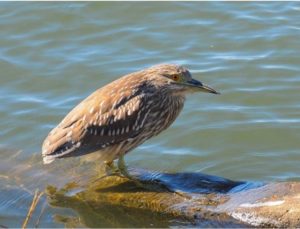Text and photo by Joe Costanza
from Medford Leas Life, December 2015

Not many avocations compel one to rise before dawn and drive 50 miles to a remote destination. However, 23 participants did just that for the Pathways to Learning birding trip to the Edwin B. Forsythe National Wildlife Refuge (Brigantine) on October 30. It was the largest Medford Leas Birders field trip group, and all were rewarded with a cool, sunny, and otherwise spectacular day of birding.
Our first birds of the day were waiting for us at the refuge parking lot. A Blue Jay greeted us with its piercing call while Yellow-rumped Warblers, House Finches, and Goldfinches eagerly searched the cedars for berries. Later, egrets and waterfowl seemed to be everywhere as our seven-car caravan meandered through the eight-mile loop road. Ospreys and a Bald Eagle soared overhead as Northern Harriers hovered over the marshes in search of prey. Hundreds of Northern Pintail ducks, dabbling bottoms up in the shallows, brought a few chuckles, and an immature Black-crowned Night Heron close to the roadway offered a thorough study.
The refuge offers a variety of unique habitats. Two water-managed impoundments contain fresh and brackish water, while the peripheral areas hold the salt marshes and the bay. The upland locations offer walking trails through wooded environments. At this time of the year, many types of waterfowl congregate in their preferred habitats to feed and rest. Ten species of waterfowl were present in the impoundments as well as related species in the bay, such as the uncommon Horned Grebe. Due to the high water levels, shorebirds were sparse, but Black-crowned Night Heron-immature Greater Yellowlegs and a small flock of Black-bellied Plovers were present. In all, the group identified 41 bird species before ending the tour with a warm, delicious and congenial lunch at Shea’s Cafe.
